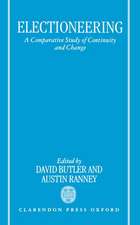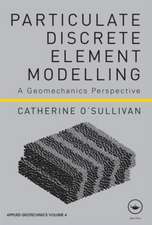Modelling, Simulation and Control of Urban Wastewater Systems
Autor Manfred Schütze, David Butler, Bruce M. Becken Limba Engleză Paperback – 31 aug 2012
| Toate formatele și edițiile | Preț | Express |
|---|---|---|
| Paperback (1) | 948.61 lei 6-8 săpt. | |
| SPRINGER LONDON – 31 aug 2012 | 948.61 lei 6-8 săpt. | |
| Hardback (1) | 954.77 lei 6-8 săpt. | |
| SPRINGER LONDON – 19 feb 2002 | 954.77 lei 6-8 săpt. |
Preț: 948.61 lei
Preț vechi: 1156.84 lei
-18% Nou
Puncte Express: 1423
Preț estimativ în valută:
181.51€ • 190.03$ • 150.19£
181.51€ • 190.03$ • 150.19£
Carte tipărită la comandă
Livrare economică 05-19 aprilie
Preluare comenzi: 021 569.72.76
Specificații
ISBN-13: 9781447111054
ISBN-10: 1447111052
Pagini: 384
Ilustrații: XVIII, 362 p.
Dimensiuni: 155 x 235 x 20 mm
Greutate: 0.54 kg
Ediția:Softcover reprint of the original 1st ed. 2002
Editura: SPRINGER LONDON
Colecția Springer
Locul publicării:London, United Kingdom
ISBN-10: 1447111052
Pagini: 384
Ilustrații: XVIII, 362 p.
Dimensiuni: 155 x 235 x 20 mm
Greutate: 0.54 kg
Ediția:Softcover reprint of the original 1st ed. 2002
Editura: SPRINGER LONDON
Colecția Springer
Locul publicării:London, United Kingdom
Public țintă
Professional/practitionerDescriere
by Professor Poul Harremoes Environmental engineering has been a discipline dominated by empirical approaches to engineering. Historically speaking, the development of urban drainage structures was very successful on the basis of pure empiricism. Just think of the impressive structures built by the Romans long before the discipline of hydraulics came into being. The fact is that the Romans did not know much about the theories of hydraulics, which were discovered as late as the mid-1800s. However, with the Renaissance came a new era. Astronomy (Galileos) and basic physics (Newton) started the scientific revolution and in the mid-1800s Navier and Stokes developed the application of Newtons laws to hydrodynamics, and later, St. Venant the first basic physics description of the motion of water in open channels. The combination of basic physical understanding of the phenomena involved in the flow of water in pipes and the experience gained by "trial and error", the engineering approach to urban drainage improved the design and performance of the engineering drainage infrastructure. However, due to the mathematical complications of the basic equations, solutions were available only to quite simple cases of practical significance until the introduction of new principles of calculation made possible by computers and their ability to crunch numbers. Now even intricate hydraulic phenomena can be simulated with a reasonable degree of confidence that the simulations are in agreement with performance in practice, if the models are adequately calibrated with sample performance data.
Cuprins
1. Introduction.- 1.1 Motivation of this Book.- 1.1.1 Administrative Responsibilities.- 1.1.2 Standards.- 1.1.3 Computer Software.- 1.1.4 Design and Operation.- 1.2 Outline of Chapters.- 2. The State of the Art.- 2.1 Components of the Urban Wastewater System: Basic Processes and Modelling Concepts.- 2.1.1 Urban Catchment Runoff and Sewer System.- 2.1.1.1 Surface Runoff in Urban Areas.- 2.1.1.2 Flow in the Sewer System.- 2.1.1.3 Pollutant Transport in the Sewer System.- 2.1.1.4 Biochemical Transformations in the Sewer System.- 2.1.1.5 Storage Tanks.- 2.1.2 The Wastewater Treatment Plant.- 2.1.2.1 Storm Tank.- 2.1.2.2 Primary Clarification.- 2.1.2.3 The Activated Sludge Process.- 2.1.2.4 Secondary Clarification.- 2.1.3 Rivers.- 2.1.3.1 River Flow.- 2.1.3.2 Pollutant Transport in the River.- 2.1.3.3 Biochemical Transformations in the River.- 2.2 Impact of Storm Events on the Urban Wastewater System.- 2.2.1 Impacts on Sewer Systems.- 2.2.2 Impacts on Treatment Plant Performance.- 2.2.3 Impacts on the Receiving River.- 2.2.4 Criteria for the Assessment of River Water Quality.- 2.2.5 The Dilemma of Control of the Urban Wastewater System.- 2.3 Integrated Modelling Approaches.- 2.4 Operational Management of Wastewater Infrastructure.- 2.4.1 General Concepts.- 2.4.2 Real-time Control of Sewer Systems.- 2.4.3 Development of Control Strategies — Exemplified for Sewer Systems.- 2.4.3.1 Off-line Development of Strategies.- 2.4.3.2 On-line Development of Strategies.- 2.4.4 Operation of Wastewater Treatment Plants.- 2.4.5 Real-time Control of Receiving Rivers.- 2.4.6 Integrated Real-time Control.- 2.4.7 Concluding Remarks.- 2.5 Mathematical Optimisation Techniques.- 2.5.1 Definition of the Optimisation Problem.- 2.5.2 A Review of Optimisation Methods.- 2.5.2.1 Local Optimisation.- 2.5.2.2 Global Optimisation.- 2.6 Conclusion.- 3. Development of the Integrated Simulation and Optimisation Tool SYNOPSIS.- 3.1 Requirements on the Simulation Tool.- 3.2 Modules Simulating the Parts of the Urban Wastewater System.- 3.2.1 Implementation of the Sewer System Module.- 3.2.2 Implementation of the Treatment Plant Module.- 3.2.2.1 The Original Implementation of Lessard and Beck’s Treatment Plant Model.- 3.2.2.2 Modifications of the Treatment Plant Model.- 3.2.3 Implementation of the River Module.- 3.3 Assembling the Integrated Simulation Tool.- 3.3.1 Integration of the Simulation Software.- 3.3.2 Variables in SYNOPSIS.- 3.3.3 Auxiliary Routines Necessary for Simulation.- 3.4 Implementation of Control in SYNOPSIS.- 3.5 Optimisation Algorithms in SYNOPSIS.- 3.5.1 Controlled Random Search.- 3.5.2 A Genetic Algorithm.- 3.5.3 Powell’s Local Optimisation Method.- 3.5.4 Interfacing the Simulation Tool with the Optimisation Routines.- 3.6 Summary: Overview of the Integrated Simulation and Optimisation Tool SYNOPSIS.- 4. Simulation of the Urban Wastewater System Using SYNOPSIS.- 4.1 Definition of a Case Study Site.- 4.1.1 Existing Data Sets.- 4.1.2 Definition of the Sewer System.- 4.1.3 Definition of the Wastewater Treatment Plant.- 4.1.4 Definition of the River.- 4.1.5 Overview of the Case Study Site Defined.- 4.2 Simulation of Dry-weather Flow.- 4.3 Simulation of a Rainfall Time Series.- 4.4 Analysis of the Control Devices of the Urban Wastewater System.- 4.5 Potential of Reduction in Simulation Time by Selective Simulation.- 4.5.1 Separation of Rainfall Events.- 4.5.2 Potential Savings in Simulation Time.- 4.5.3 Selective Versus Continuous Simulation.- 4.5.4 Conclusions.- 5. Analysis of Control Scenarios by Simulation and Optimisation.- 5.1 Definitions and Methodology.- 5.2 Analysis of Strategy Parameters — an Example.- 5.2.1 Definition of a Strategy Framework.- 5.2.2 Exploring the Parameter Space by Gridding.- 5.2.3 Optimisation of Strategy Parameters.- 5.3 A Top-down Approach to the Definition of Control Strategies.- 5.3.1 Definition of Various Frameworks.- 5.3.2 Evaluation of the Optimisation Algorithms.- 5.3.3 Conclusions.- 5.4 A Bottom-up Approach to the Definition of Control Strategies.- 5.4.1 Towards a Systematic Definition of Frameworks.- 5.4.2 Analysis of Frameworks Involving Several Controllers.- 5.5 Integrated Versus Local Control.- 5.6 Further Aspects.- 5.6.1 Sensitivity of Solutions.- 5.6.2 Multi-objective Optimisation.- 5.6.3 Simulation Period Required for Optimisation.- 5.6.4 Control Potential of Various Case Study Sites.- 6. Conclusions and Further Research.- 6.1 Summary.- 6.2 Suggestions for Further Research.- Appendix A. Overview of Existing Software.- A.1 Software for Simulation of Sewer Systems.- A.2 Software for Simulation of Activated Sludge Wastewater Treatment Plants.- A.3 Software for Simulation of Rivers.- Appendix B. Parameters of the Treatment Plant Model.- Appendix C. Rainfall Data Used in This Study.- Appendix D. Detailed Results of Optimisation Runs Presented in Chapter 5.- References.
Caracteristici
This book demonstrates new ways of looking at wastewater processing - a subject of extreme importance in the increasingly urbanised world of the 21st Century, much of which still relies on the infrastructure of the 19th
Current concern over water quality and other "green" issues makes the up-to-date control of all forms of aquatic pollution and of effluent in particular a high-profile ecological issue
Current concern over water quality and other "green" issues makes the up-to-date control of all forms of aquatic pollution and of effluent in particular a high-profile ecological issue















